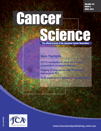Imaging and biodistribution of Her2/neu expression in non-small cell lung cancer xenografts with 64Cu-labeled trastuzumab PET
Correction added on 7 September 2023, after initial online publication. A duplicate of this article was published under the DOI 10.1111/j.1347-9032.2009.01480.x. This duplicate has now been deleted and its DOI redirected to this version of the article.
Abstract
Non-small cell lung carcinomas (NSCLC) overexpress the Her2/neu gene in approximately 59% of cases. Trastuzumab, a humanized monoclonal antibody, interferes with Her2 signaling and is approved for the treatment of Her2/neu overexpressing breast cancer. However, its therapeutic use in Her2/neu overexpressing NSCLC remains obscure. The present study aimed to determine the role of 64Cu-labeled trastuzumab positron emission tomography (PET) for non-invasive imaging of Her2/neu expression in NSCLC. Trastuzumab was conjugated with the bifunctional chelator 1, 4, 7, 10-tetraazacyclododecane-1, 4, 7, 10-tetraacetic acid (DOTA) and radiolabeled with 64Cu. The molecular specificity of DOTA-trastuzumab was determined in NSCLC cell lines with Her2/neu overexpression (NCI-H2170) and negative expression (NCI-H520). Imaging of Her2/neu expression was performed in NCI-H2170 tumor-bearing mice with 64Cu-DOTA-trastuzumab PET and 64Cu-DOTA-IgG. In vitro studies revealed specific binding of DOTA-trastuzumab in the Her2/neu positive NCI-H2170 cells, while no binding was seen in the Her2/neu negative NCI-H520 cell line. Biodistribution and PET studies revealed a significantly high accumulation of 64Cu-DOTA-trastuzumab in the Her2/neu overexpressing NCI-H2170 tumor at 24 and 48 h post-injection (21.4 ± 1.4% and 23.2 ± 5.1% injection dose/gram (% ID/g), respectively). PET imaging of Her2/neu negative NCI-H520 tumors showed much less uptake of 64Cu-DOTA-trastuzumab (4.0% ID/g). The NCI-H2170 tumor uptake of 64Cu-DOTA-trastuzumab was significantly higher than that of 64Cu-DOTA-IgG (P < 0.0001). 64Cu-DOTA-trastuzumab showed a very clear image of a Her2/neu positive tumor and appeared to be effective as a PET tracer for imaging of Her2/neu gene expression in NSCLC, suggesting its potential clinical use for identifying patients that might benefit from trastuzumab-based therapy.
(Cancer Sci 2010; 101: 1045–1050)




